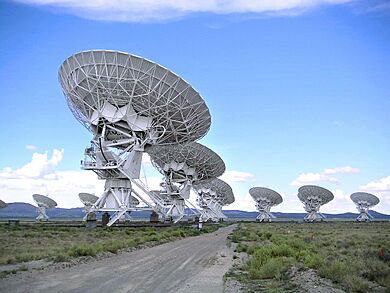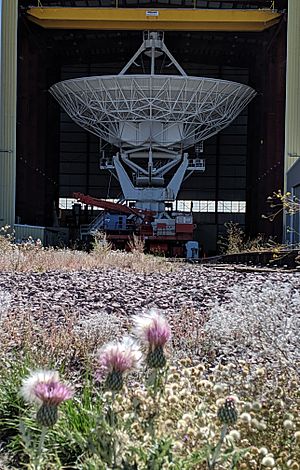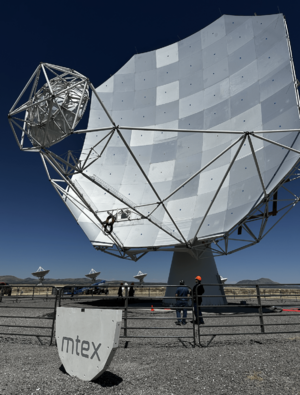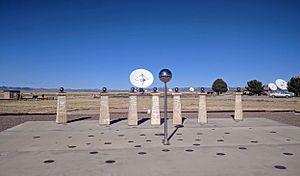Very Large Array facts for kids
 |
|
| Alternative names | VLA |
|---|---|
| Location(s) | Socorro County, New Mexico |
| Coordinates | 34°04′43″N 107°37′04″W / 34.0787492°N 107.6177275°W |
| Altitude | 2,124 m (6,969 ft) |
| Wavelength | 0.6 cm (50 GHz)–410 cm (73 MHz) |
| Built | 1973–1981 |
| Diameter | |
| Website | science |
| |
|
The Karl G. Jansky Very Large Array (VLA) is a giant radio astronomy observatory located in the desert of central New Mexico. Instead of using light we can see, it listens to radio waves coming from space. These are the same kind of waves that bring music to your radio, but they also come from stars, galaxies, and other amazing objects in the universe.
The VLA is made of 28 huge radio telescopes, also called antennas or dishes. Twenty-seven of these antennas work together, while one is always being checked and fixed. They are arranged in a giant Y-shape on the Plains of San Agustin. By working together, these dishes act like one enormous telescope, which allows scientists to see the universe in incredible detail.
Astronomers use the VLA to study some of the most mysterious things in space. They have made important discoveries about black holes, young stars that are just forming planets, and the center of our own Milky Way galaxy. The VLA helps us understand how the universe works. It is part of the National Radio Astronomy Observatory (NRAO).
Contents
How Does the VLA Work?
The VLA is a powerful tool because all 27 of its antennas work as a team. This technique is called interferometry. Each antenna dish is 25 meters (82 feet) wide and weighs as much as a blue whale.
The antennas are set up on three arms of railroad tracks that form a Y-shape. Each arm is 21 kilometers (13 miles) long. A special train called "Hein's Trein" can move the giant antennas along these tracks. By changing the positions of the antennas, astronomers can change how the telescope "zooms in" on the sky.
Telescope Configurations
There are four main setups, or configurations, for the antennas:
- A Configuration: This is the largest setup, where the antennas are spread out as far as possible. This gives the VLA its best "zoom," allowing it to see very fine details.
- D Configuration: This is the smallest setup, where all the antennas are close together, within 600 meters of the center. This is good for getting a wider view of large objects in space.
The observatory changes between these setups every few months. This allows scientists to study many different kinds of objects in the sky.
What Can the VLA "Hear"?
The VLA can detect a wide range of radio waves. The control center for the VLA is located in Socorro, New Mexico, at the New Mexico Institute of Mining and Technology. This center also controls another telescope called the Very Long Baseline Array (VLBA), which has antennas spread all the way from Hawaii to the U.S. Virgin Islands.
Upgrades and a New Name
In 2011, the VLA finished a huge 10-year upgrade. Its old 1970s electronics were replaced with modern technology. This made the telescope thousands of times more powerful.
To celebrate this big improvement, the observatory was renamed the "Karl G. Jansky Very Large Array." The name honors Karl G. Jansky, the scientist who first discovered radio waves coming from space in the 1930s.
The Next Generation VLA
The VLA is getting another massive upgrade to become the Next Generation Very Large Array (ngVLA). This project will replace the old antennas with over 260 new ones. These new antennas will be spread across New Mexico, Texas, Arizona, and even northern Mexico. Some will be placed as far away as Hawaii, Washington state, and Germany.
The ngVLA will be ten times more powerful than the current VLA. It will allow astronomers to see the universe with even more amazing detail. A prototype for the new antennas was installed in February 2025.
What Has the VLA Discovered?
The VLA is a very flexible tool that can study almost anything in the sky that gives off radio waves. Scientists have used it to look at:
- Radio galaxies and quasars: Extremely bright objects far across the universe.
- Black holes: Studying the gas and stars that swirl around them.
- Young Stars: Looking at the disks of dust and gas where planets are born.
- The Milky Way: Mapping the gas and magnetic fields at the center of our own galaxy.
- Supernova Remnants: The clouds of gas left behind when a giant star explodes.
- The Sun and Planets: Even objects in our own solar system can be studied with the VLA.
In 1989, the VLA was even used to pick up signals from the Voyager 2 spacecraft as it flew past the planet Neptune.
One of its biggest projects is the VLA Sky Survey (VLASS). This survey is scanning 80% of the sky three times. Astronomers expect to find about 10 million new radio-emitting objects, which is four times more than we knew about before.
History of the VLA
The idea for the VLA came from an astronomer named David S. Heeschen. The U.S. government approved the project in 1972, and construction started soon after. The first antenna was put in place in 1975, and the whole observatory officially opened in 1980.
The VLA became famous when it was featured in the 1997 movie ..., which was based on a book by the famous astronomer Carl Sagan.
Visiting the VLA
The VLA is open to visitors. There is a visitor center with a museum and a gift shop. You can take a self-guided walking tour to see the giant antennas up close.
The VLA is in a remote desert area, so it's a good idea to bring your own food and water. The weather can also change quickly. For people who can't visit in person, the NRAO has created a virtual tour online called the VLA Explorer.
See also
 In Spanish: Karl G. Jansky Very Large Array para niños
In Spanish: Karl G. Jansky Very Large Array para niños
- Atacama Large Millimeter Array (ALMA)
- Green Bank Telescope (GBT)
- List of radio telescopes
- Square Kilometre Array (SKA)






